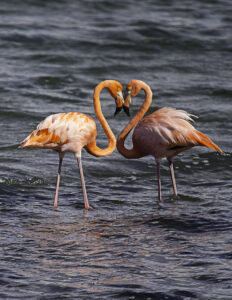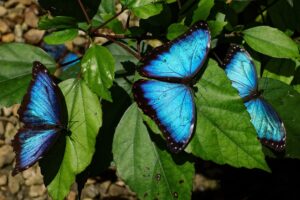The natural world is full of vibrant colors, from the deep red of autumn leaves to the lush greens of the tropics. But there is one color that you don’t see quite so often– blue. While we do live on a blue planet (on account of all the water), there aren’t many examples of blue life on terra firma. Less than one in ten plants have blue flowers simply because there are very, very few true blue pigments in nature; plants have to mix pigments to appear blue. There’s a practical reason for the lack of blue as well. You may know about chlorophyll, the most common pigment in plants. It appears green because it reflects green light while absorbing the other wavelengths, or colors, of light to use during photosynthesis. Blue light has the highest energy of light in the visible spectrum, so it is therefore the most useful to plants. A blue pigment would reflect that light away, and why would a plant want to spit out the most useful portion of the light it receives?

Animals, on the other hand, don’t have to worry about photosynthesis, but are still limited by that pesky pigment problem. See, color in the animal kingdom is generally the food that a creature eats. Flamingos, for example, get their pink feathers from the shrimp and algae that they like to chow down on. Without those in their diet, they’d actually be white! Since there are very few blue pigments in plants, there are very few in animals as well.
But I bet you can think of many different animals that are blue: blue jays, parrots, butterflies, baboons. They all get their blue hues through a fascinating phenomenon known as structural color. Take the blue Morpho butterfly, a truly massive insect with brilliant blue wings that makes its home in the Amazon. The Morpho doesn’t get that color from any pigments, but rather because of the nanoscopic structures within its wings. The structures resemble closely packed fern leaves, but scaled way, way down.

When sunlight, or white light, hits them, only certain wavelengths of light can escape from the maze of nanostructures. In principle, any color could be the one that makes it out, but in the case of the Morpho, the observer is presented with a beautiful iridescent blue. This same structural coloring is how birds and other animals don their spectacular blues.
Blue colors are easily attainable for us humans now that we have access to synthetic dyes, but plants and animals will continue to struggle to get the blues.
Peer Editor: Kirsten Giesbrecht